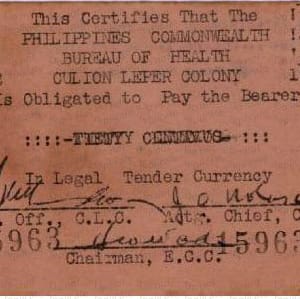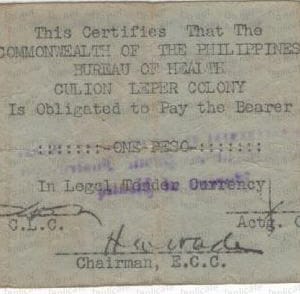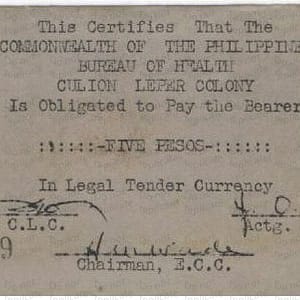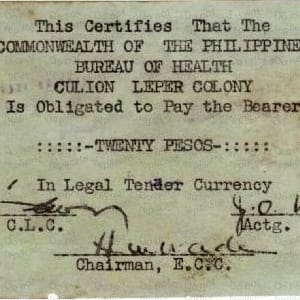The Culion Leper Colony was administered by the Commonwealth Bureau of Health. Normal monthly expenditure was about 25,000 pesos, most of which was obtained directly from Manila. The outbreak of the war effectively severed the source of that supply.
Funds on hand were nearly exhausted in meeting the December 1941 payroll. The special Culion coinage was reissued, but was only a stop-gap measure. In late January, 1942 at a public meeting a proposal was adopted to issue “local scrip”. A Currency Committee was formed consisting of Dr. H. W. Wade, Medical Director of the Leonard Wood Memorial, as Chairman, with Acting Chief Pathologist Jose O. Nolasco and Disbursing Officer Julio Lisboa as Members.
The scrip was mimeographed on pink paper for centavo denominations and blue paper for peso denominations. The Bureau of Health stamping was applied on the back in blue. Notes were dipped in paraffin for durability.
The currency was accepted reluctantly at first, so an appeal was sent to President Quezon, who then replied as follows-
IF NECESSARY ISSUE NOTES FOR PAYMENT OF SALARIES AND OTHER EXPENSES. THESE NOTES WILL BE REDEEMED BY GOVERNMENT LATER.
President Quezon via telegraph on February 9, 1942
Upon receipt of presidential authority, this authority designation was printed on the back of the notes, and all notes had the Bureau of Health stamping in blue. None of the 1, 5 or 20 Peso notes had the presidential authority clause on the reverse. The notes with authorization are rarer than the ones without.
A total of 144,485 pesos was printed, but only 92,130 pesos placed in circulation. When Japanese military scrip arrived at the end of July, 1942, use of Culion scrip was officially prohibited.
A few years ago a hoard of these notes was discovered, making them much more obtainable. I have conferred with Neil Schafer, and he believes this hoard to contain authentic notes.





